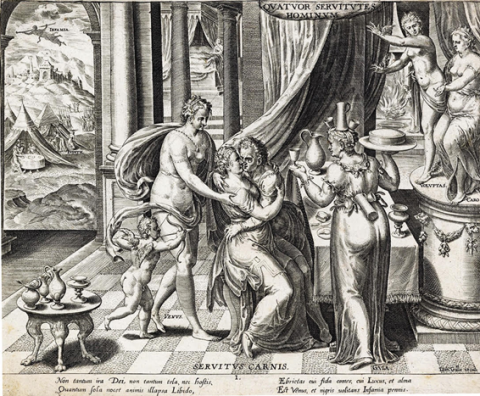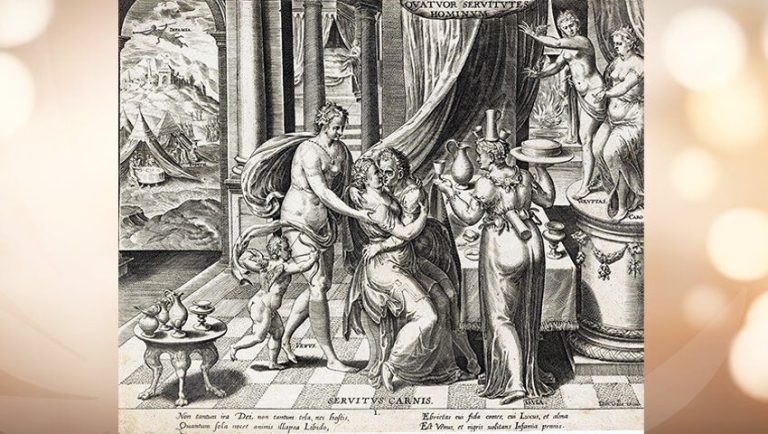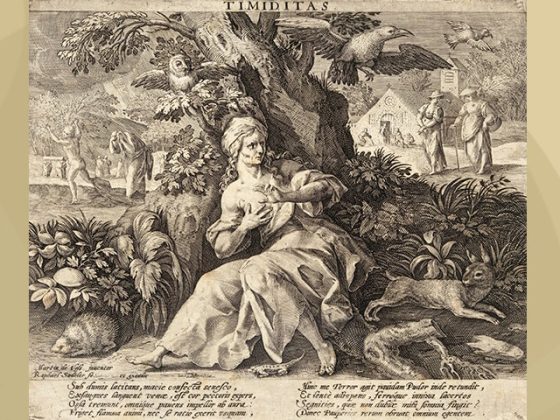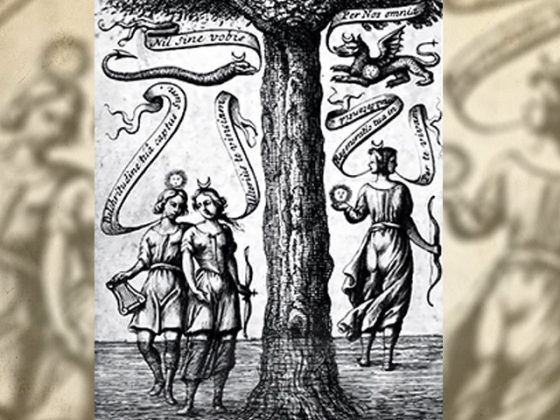Most endearing reader friends:
I hasten to send you, in the coming messages, four engravings made approximately in the year 1573 by Gérard Van Groeningen (1550-1599), a Flemish designer well-known in Antwerp ─Belgium─.
Such a series of engravings is called The Four Ways of Living on Earth. On this occasion I am sending you only the first of them entitled…
…CULTURA CARNIS
─'The Way of the Flesh'─
Engraving No. 1

Gérard Van Groeningen (1550-1599)
This first engraving emphasizes the following: QVATVOR SERVITUTES HOMINUM, ‘there are four slaveries of men'.
In it we can see a scene in which a group of people is clearly seen participating in lustful and lascivious acts.
On the one hand, we see a seated couple indulging in lustful excesses. Such a couple is served by a woman who carries with her in her hands, on her head and on her waist a series of utensils for the purpose of lavishing the lovers with the enjoyment of various gastronomic dishes while they are enjoying their sexual identification. It is for this reason that, at the feet of this servant woman, we find the Latin word gvla ─namely: ‘gluttony'─ alluding to the pleasures caused by this psychological aggregate.
It should also be noted that near the aforementioned couple there is a representation of the goddess Venus, who is accompanied by Eros-Cupid, who is pointing his arrows at the couple in our engraving. Understand here that it is not that Venus –the Goddess of Love– is complacent with these attitudes, no. It is that the author of the engraving, wanting to express human weaknesses, shows this divinity as a representation of a misdirected eroticism.
Through Gnosis we come to understand our correct relationship with the erotic force and we sublimate it according to the parameters of the science of Tantra-Yoga or Kundalini-Yoga. In this way we do not end up being slaves of sex, but we use this force transmuted in our organic anatomy to develop our animic faculties and become true men in the image and likeness of the Creator.
Obviously, the Roman clergy, with their absurd systems of sexual abstention, cause glandular degenerations in our organism, and this is reversed in the same organism in the form of the so-called venenioosskirian vibrations…, which turn us into obese, fat persons, or into meagre, skinny individuals full of expert cynicism.
On the right side of our engraving we see, on a kind of table, two figures. It is two women. The first of them wears wings on her wrists and is in an attitude of showing herself as someone special. At her feet appears the Latin word Voluptas, which should be translated as ‘pleasure', delight without limits. Certainly, our humanity has fallen into the unbridled delight of the pleasures of the flesh. This is called hedonism today, which means living only for the enjoyment that the five senses provide us with. The other woman, who is next to voluptuousness, has at her feet another Latin word that identifies her. This is Caro, which is to be translated as ‘flesh'. Thus, in this way, the “I's” or psychological aggregates of voluptuousness are accompanied when it comes to producing pleasures in the human being.
On the other hand, it has always been said that, normally, the animalistic sexual passions go hand in hand with the egoic states of inebriation, drunkenness, gluttony, etc., etc., etc. That is why, apart from the central motif of our engraving, on the left side, we see a set of tents, and inside one of them we see the famous Iudith, or Judith, beheading the famous Holofernes. This story is amply documented in the sacred scriptures and alludes to the decapitation of our abominable animal Ego.
In the sky of that part of the engraving we see a creature flying carrying a trumpet and being accompanied by the Latin word Infamia. This is to tell us that, without a doubt, we have turned our life into a true infamy, far removed from any exalting principle that leads us to the kingdom of the Father. That is why we see that the creature that flies does so over the people at its feet to indicate to us that this happens everywhere on our globe.
Next to the lady who represents voluptuousness, we can see some flames that are fed by a person. These flames symbolize human passions.
At the bottom of our engraving we can see some sentences written in Latin. They tell us things like these:
«Non tantum ira Dei, non tantum tela, nec hostis
Quantum sola nocet animis illapsa Libido,
Ebrietas cui fida comes, cui Luxus, et alma
Est Venus, et nigris uolitans Infamia pennis».
Translation:
‘Not the wrath of the Gods, nor weapons, nor an enemy, harm souls so much, as when by itself the lust that has penetrated, of which drunkenness and luxury are faithful companions, and Venus who gives life, and infamy flying with black feathers.'
Allow me now, dear readers, to give you a few sentences that are well worth reflecting upon:
“All other sins are intrinsically evil; that of scandal is extrinsically so.”
P. Vitoria
“Those who have the most frivolous idea of sin are precisely those who suppose an abyss between honest people and others.”
Amiel
“No one should blame anyone for the sins that are committed, but only himself.”
Cervantes
“To know sin is the beginning of salvation.”
Seneca
“As soon as a man thinks himself incapable of committing the sins of another, he becomes merciless in judging them. His punishment is then usually… to commit even greater ones.”
Graham Greene
ABYSSUS ABYSSUM INVOCAT.
─‘One abyss calls for another abyss’─.
KWEN KHAN KHU





